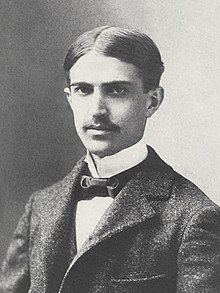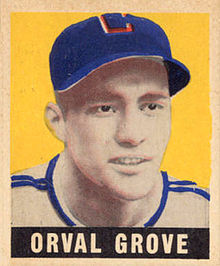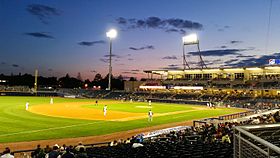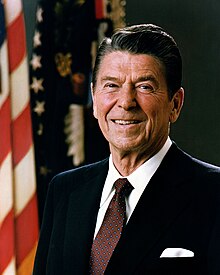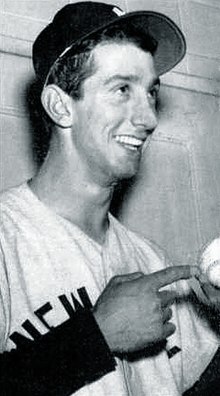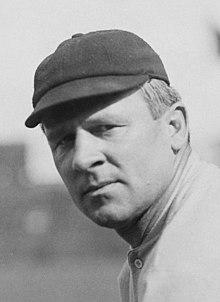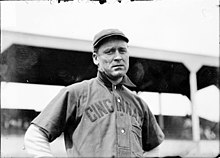Portal:Baseball
Portal maintenance status: (June 2018)
|
| Main page | Content, Categories & Topics | WikiProjects & Things you can do |
The Baseball Portal
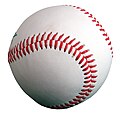
Baseball is a bat-and-ball sport played between two teams of nine players each, taking turns batting and fielding. The game occurs over the course of several plays, with each play generally beginning when a player on the fielding team, called the pitcher, throws a ball that a player on the batting team, called the batter, tries to hit with a bat. The objective of the offensive team (batting team) is to hit the ball into the field of play, away from the other team's players, allowing its players to run the bases, having them advance counter-clockwise around four bases to score what are called "runs". The objective of the defensive team (referred to as the fielding team) is to prevent batters from becoming runners, and to prevent runners' advance around the bases. A run is scored when a runner legally advances around the bases in order and touches home plate (the place where the player started as a batter).
The opposing teams switch back and forth between batting and fielding; the batting team's turn to bat is over once the fielding team records three outs. One turn batting for each team constitutes an inning. A game is usually composed of nine innings, and the team with the greater number of runs at the end of the game wins. Most games end after the ninth inning, but if scores are tied at that point, extra innings are usually played. Baseball has no game clock, though some competitions feature pace-of-play regulations such as the pitch clock to shorten game time.
Baseball evolved from older bat-and-ball games already being played in England by the mid-18th century. This game was brought by immigrants to North America, where the modern version developed. Baseball's American origins, as well as its reputation as a source of escapism during troubled points in American history such as the American Civil War and the Great Depression, have led the sport to receive the moniker of "America's Pastime"; since the late 19th century, it has been unofficially recognized as the national sport of the United States, though in modern times is considered less popular than other sports, such as American football. In addition to North America, baseball spread throughout the rest of the Americas and the Asia–Pacific in the 19th and 20th centuries, and is now considered the most popular sport in parts of Central and South America, the Caribbean, and East Asia, particularly in Japan, South Korea, and Taiwan. (Full article...)
 Featured articles - load new batch
Featured articles - load new batch
-
Image 1Los Angeles Angels center fielder Mike Trout hits a home run on a pitch from New York Mets pitcher Tommy Milone on May 21, 2017.
Baseball is a bat-and-ball sport played between two teams of nine players each, taking turns batting and fielding. The game occurs over the course of several plays, with each play generally beginning when a player on the fielding team, called the pitcher, throws a ball that a player on the batting team, called the batter, tries to hit with a bat. The objective of the offensive team (batting team) is to hit the ball into the field of play, away from the other team's players, allowing its players to run the bases, having them advance counter-clockwise around four bases to score what are called "runs". The objective of the defensive team (referred to as the fielding team) is to prevent batters from becoming runners, and to prevent runners' advance around the bases. A run is scored when a runner legally advances around the bases in order and touches home plate (the place where the player started as a batter).
The initial objective of the batting team is to have a player reach first base safely; this generally occurs either when the batter hits the ball and reaches first base before an opponent retrieves the ball and touches the base, or when the pitcher persists in throwing the ball out of the batter's reach. Players on the batting team who reach first base without being called "out" can attempt to advance to subsequent bases as a runner, either immediately or during teammates' turns batting. The fielding team tries to prevent runs by using the ball to get batters or runners "out", which forces them out of the field of play. The pitcher can get the batter out by throwing three pitches which result in strikes, while fielders can get the batter out by catching a batted ball before it touches the ground, and can get a runner out by tagging them with the ball while the runner is not touching a base. (Full article...) -
Image 2

Ichiro Suzuki was the first high-profile NPB player (second overall) to use the posting system.
The posting system (ポスティングシステム, posutingu shisutemu) is a baseball player transfer system that operates between Nippon Professional Baseball (NPB) and Major League Baseball (MLB). Despite the drafting of the United States – Japanese Player Contract Agreement, unveiled in 1967 to regulate NPB players moving to MLB, problems began to arise in the late 1990s. Some NPB teams lost star players without compensation, an issue highlighted when NPB stars Hideo Nomo and Alfonso Soriano left to play in MLB after using loopholes to void their existing contracts. A further problem was that NPB players had very little negotiating power if their teams decided to deal them to MLB, as when pitcher Hideki Irabu was traded to an MLB team for which he had no desire to play. In 1998, the Agreement was rewritten to address both problems; the result was dubbed the "posting system".
Under this system, when an NPB player is "posted", his NPB team notifies the MLB Commissioner, with the posting fee based on the type of contract a player signs and its value. For minor-league contracts, the fee is a flat 25% of contract's value; for MLB contracts, the fee is based on the value of the contract that the posted player eventually signs. The player is then given 30 days to negotiate with any MLB team willing to pay the NPB team's posting fee. If the player agrees on contract terms with a team before the 30-day period has expired, the NPB team receives the posting fee from the signing MLB team as a transfer fee, and the player is free to play in MLB. If no MLB team comes to a contract agreement with the posted player, then no fee is paid, and the player's rights revert to his NPB team. The current process replaced one in which MLB held a silent auction during which MLB teams submitted sealed, uncapped bids in an attempt to win the exclusive negotiating rights with the posted player for a period of 30 days. Once the highest bidding MLB team was determined, the player could then only negotiate with that team. (Full article...) -
Image 3
Mariano Rivera (born November 29, 1969) is a Panamanian-American former professional baseball pitcher who played 19 seasons in Major League Baseball (MLB) for the New York Yankees, from 1995 to 2013. Nicknamed "Mo" and "Sandman", he spent most of his career as a relief pitcher and served as the Yankees' closer for 17 seasons. A thirteen-time All-Star and five-time World Series champion, he is MLB's career leader in saves (652) and games finished (952). Rivera won five American League (AL) Rolaids Relief Man Awards and three Delivery Man of the Year Awards, and he finished in the top three in voting for the AL Cy Young Award four times. He was inducted into the Baseball Hall of Fame as part of its class of 2019 in his first year of eligibility, and is to date the only player ever to be elected unanimously by the Baseball Writers' Association of America (BBWAA).
Raised in the modest Panamanian fishing village of Puerto Caimito, Rivera was an amateur player until he was signed by the Yankees organization in 1990. He debuted in the major leagues in 1995 as a starting pitcher, before permanently converting to a relief pitcher late that year. After a breakthrough season in 1996 as a setup man, he became the Yankees' closer in 1997. In the following seasons, he established himself as one of baseball's top relievers, leading the major leagues in saves in 1999, 2001, and 2004. Rivera primarily threw a sharp-moving, mid-90s mile-per-hour cut fastball that frequently broke hitters' bats and earned a reputation as one of the league's toughest pitches to hit. With his presence at the end of games, signaled by his foreboding entrance song "Enter Sandman", Rivera was a key contributor to the Yankees' dynasty in the late 1990s and early 2000s that won four championships in five years. He was an accomplished postseason performer, winning the 1999 World Series Most Valuable Player (MVP) Award and the 2003 AL Championship Series MVP Award, while setting postseason records that included lowest earned run average (ERA) (0.70) and most saves (42). (Full article...) -
Image 4
Stephen Crane (November 1, 1871 – June 5, 1900) was an American poet, novelist, and short story writer. Prolific throughout his short life, he wrote notable works in the Realist tradition as well as early examples of American Naturalism and Impressionism. He is recognized by modern critics as one of the most innovative writers of his generation.
The ninth surviving child of Methodist parents, Crane began writing at the age of four and had several articles published by 16. Having little interest in university studies though he was active in a fraternity, he left Syracuse University in 1891 to work as a reporter and writer. Crane's first novel was the 1893 Bowery tale Maggie: A Girl of the Streets, generally considered by critics to be the first work of American literary Naturalism. He won international acclaim for his Civil War novel The Red Badge of Courage (1895), considered a masterpiece by different critics and writers. (Full article...) -
Image 5
Orval Leroy Grove (August 29, 1919 – April 20, 1992) was an American professional baseball pitcher in Major League Baseball who played for ten seasons in the American League with the Chicago White Sox. In 207 career games, Grove pitched 1,176 innings and posted a win–loss record of 63–73, with 66 complete games, 11 shutouts, and a 3.78 earned run average (ERA).
The only freshman on the Proviso Township High School varsity baseball team, Grove's pitching ability attracted the attention of the White Sox. After signing with the team in 1937, Grove moved between the major leagues and minor leagues for a few seasons until 1943, when he found a solid place in the White Sox's pitching rotation. Grove had a career-year in 1943, finishing the season with career-bests in ERA, wins, and complete games; in 1944, he made his only All-Star appearance. (Full article...) -
Image 6
A picture of a Wii Sports disc
Wii Sports is a 2006 sports simulation video game developed and published by Nintendo for the Wii video game console. The game was released in North America along with the Wii on November 19, 2006, and in Japan, Australia, and Europe the following month. It was included as a pack-in game with the console in all territories except Japan, making it the first sports game included with the launch of a Nintendo system since Mario's Tennis for the Virtual Boy in 1995. The game was later released on its own as part of the Nintendo Selects collection of games.
Wii Sports is a collection of five sports simulations designed to demonstrate the motion-sensing capabilities of the Wii Remote. The five sports included are tennis, baseball, bowling, golf, and boxing. Players use the Wii Remote to mimic actions performed in real-life sports, such as swinging a tennis racket or rolling a bowling ball. The rules for each game are simplified to make them more accessible to new players. The game also features training and fitness modes that monitor players' progress in the sports. (Full article...) -
Image 7
Robert William Andrew Feller (November 3, 1918 – December 15, 2010), nicknamed "the Heater from Van Meter", "Bullet Bob", and "Rapid Robert", was an American baseball pitcher who played 18 seasons in Major League Baseball (MLB) for the Cleveland Indians between 1936 and 1956. In a career spanning 570 games, Feller pitched 3,827 innings and posted a win–loss record of 266–162, with 279 complete games, 44 shutouts, and a 3.25 earned run average (ERA). His career 2,581 strikeouts were third all-time upon his retirement.
A prodigy who bypassed baseball's minor leagues, Feller made his debut with the Indians at the age of 17. His career was interrupted by four years of military service (1942–1945) as a United States Navy Chief Petty Officer aboard USS Alabama during World War II. Feller became the first pitcher to win 24 games in a season before the age of 21. He threw no-hitters in 1940, 1946, and 1951, and 12 one-hitters, both records at his retirement. He helped the Indians win a World Series title in 1948 and an American League-record 111 wins and the pennant in 1954. Feller led the American League in wins six times and in strikeouts seven times. In 1946 he recorded 348 strikeouts, the most since 1904 and then believed to be a record. (Full article...) -
Image 8
First Horizon Park, formerly known as First Tennessee Park, is a baseball park in downtown Nashville, Tennessee, United States. The home of the Triple-A Nashville Sounds of the International League, it opened on April 17, 2015, and can seat up to 10,000 people. It replaced the Sounds' former home, Herschel Greer Stadium, where the team played from its founding in 1978 through 2014.
The park was built on the site of the former Sulphur Dell, a minor league ballpark in use from 1885 to 1963. It is located between Third and Fifth Avenues on the east and west (home plate, the pitcher's mound, and second base are directly in line with Fourth Avenue to the stadium's north and south) and between Junior Gilliam Way and Harrison Street on the north and south. The Nashville skyline can be seen from the stadium to the south. (Full article...) -
Image 9Michael Lee Capel (born October 13, 1961) is an American professional baseball pitcher who played in Major League Baseball (MLB) for the Chicago Cubs, the Milwaukee Brewers, and the Houston Astros. In 49 career games, Capel pitched 62+1⁄3 innings, struck out 43 batters, and had a career win–loss record of 3–4 with a 4.62 earned run average (ERA). While he played in MLB, Capel stood at 6 feet 1 inch (185 cm) and weighed 175 pounds (79 kg). A starting pitcher in college and parts of his Minor League Baseball career, he converted to relief pitching while in Chicago's minor league system.
The Philadelphia Phillies chose Capel in the 24th round of the 1980 MLB draft, but the 18-year-old did not sign with the team; instead, he opted to attend the University of Texas. Capel played on the 1982 USA College All-Star Team, which competed in the Amateur World Series in Seoul and placed third. The next year, Capel and the Texas Longhorns won the College World Series. After he was drafted by the Cubs, Capel left Texas and signed to play professional baseball; he played in six seasons of Minor League Baseball before he made his MLB debut in 1988. Capel spent the entire 1989 season in Triple-A, one level below the majors, but the Cubs released him at the end of the year. He agreed to terms with the Brewers and played in MLB after an injury opened a spot on Milwaukee's roster, but was again released at the end of the season. A free agent, the Astros signed Capel, and over the course of the season he pitched in 25 games for the team. He spent the final part of his career in the Astros farm system, and after he made the 1992 Triple-A All-Star team, Capel played his last season in 1993. After retirement, Capel worked as the general manager of a car dealership in Houston, Texas. (Full article...) -
Image 10
Ronald Wilson Reagan (February 6, 1911 – June 5, 2004) was an American politician and actor who served as the 40th president of the United States from 1981 to 1989. A member of the Republican Party, he became an important figure in the American conservative movement, and his presidency is known as the Reagan era.
Born and raised in Illinois, Reagan graduated from Eureka College in 1932 and was hired the next year as a sports broadcaster in Iowa. In 1937, he moved to California where he became a well-known film actor. During his acting career, Reagan was elected president of the Screen Actors Guild twice, serving from 1947 to 1952 and from 1959 to 1960. In the 1950s, he became the host for General Electric Theater and also worked as a motivational speaker for General Electric. Subsequently, Reagan's "A Time for Choosing" speech during the 1964 U.S. presidential election launched his rise as a leading conservative figure. After being elected governor of California in 1966, he raised the state taxes, turned the state budget deficit into a surplus and implemented harsh crackdowns on university protests. Following his loss to Gerald Ford in the 1976 Republican Party presidential primaries, Reagan won the Republican Party's nomination and then a landslide victory over President Jimmy Carter in the 1980 presidential election. (Full article...) -
Image 11
Arthur Joseph Houtteman (August 7, 1927 – May 6, 2003) was an American right-handed pitcher in Major League Baseball who played for 12 seasons in the American League with the Detroit Tigers, Cleveland Indians and Baltimore Orioles. In 325 career games, Houtteman pitched 1,555 innings and posted a win–loss record of 87–91, with 78 complete games, 14 shutouts, and a 4.14 earned run average (ERA).
Known on the sandlot for his pitching motion, Houtteman was signed by scout Wish Egan in 1945 at 17 years of age. He was recruited by major league teams, and joined a Tigers pitching staff that had lost players to injuries and World War II. After moving between the major and minor leagues over the next few years, he was nearly killed in an automobile accident just before the 1949 season. Houtteman rebounded from his injuries and went on to win 15 games that season and made his only All-Star appearance in the following year. (Full article...) -
Image 12
Alfred Manuel "Billy" Martin Jr. (May 16, 1928 – December 25, 1989) was an American Major League Baseball second baseman and manager who, in addition to leading other teams, was five times the manager of the New York Yankees. First known as a scrappy infielder who made considerable contributions to the championship Yankee teams of the 1950s, he then built a reputation as a manager who would initially make bad teams good, before ultimately being fired amid dysfunction. In each of his stints with the Yankees he managed them to winning records before being fired by team owner George Steinbrenner or resigning under fire, usually amid a well-publicized scandal such as Martin's involvement in an alcohol-fueled fight.
Martin was born in a working-class section of Berkeley, California. His skill as a baseball player gave him a route out of his home town. Signed by the Pacific Coast League Oakland Oaks, Martin learned much from Casey Stengel, the man who would manage him both in Oakland and in New York, and enjoyed a close relationship with Stengel. Martin's spectacular catch of a wind-blown Jackie Robinson popup late in Game Seven of the 1952 World Series saved that series for the Yankees, and he was the hitting star of the 1953 World Series, earning the Most Valuable Player award in the Yankee victory. He missed most of two seasons, 1954 and 1955, after being drafted into the Army, and his abilities never fully returned; the Yankees traded him after a brawl at the Copacabana club in New York during the 1957 season. Martin bitterly resented being traded, and did not speak to Stengel for years, a time during which Martin completed his playing career with various teams. (Full article...) -
Image 13

Hershiser pitching for the Dodgers in 1993
During the 1988 Major League Baseball season, pitcher Orel Hershiser of the Los Angeles Dodgers set the MLB record for consecutive scoreless innings pitched. Over 59 consecutive innings, opposing hitters did not score a run against Hershiser. During the streak, he averted numerous high-risk scoring situations. The streak spanned from the sixth inning of an August 30 game against the Montreal Expos to the 10th inning of a September 28 game against the San Diego Padres. The previous record of 58+2⁄3 innings was set by former Dodger pitcher Don Drysdale in 1968; as the team's radio announcer, Drysdale called Hershiser's streak as he pursued the new record. Pundits have described the streak as among the greatest records in baseball history, with one pundit ranking it among the greatest individual feats in American sports.
During the streak, the Elias Sports Bureau changed its criteria for the official consecutive scoreless innings record for starting pitchers from including fractional innings in which one or two outs had been recorded to counting only complete scoreless innings. Since the streak was active at the end of the 1988 season, it could have spanned two separate seasons. However, Hershiser yielded a run in his first inning of work in the 1989 season against the Cincinnati Reds, thus ending the streak at 59 consecutive scoreless innings pitched. The streak includes only innings pitched in the regular season, excluding eight scoreless innings Hershiser pitched to start Game 1 of the 1988 National League Championship Series on October 4 (unofficially extending his streak to 67 combined innings). Although he completed the ninth inning in each start, the streak's final game lasted 16 innings, of which he pitched only the first 10. Thus, Hershiser did not match Drysdale's record of six consecutive complete game shutouts. Like Drysdale's streak, the penultimate game of Hershiser's streak was a Dodgers–Giants game that featured a controversial umpire's ruling that saved the streak. (Full article...) -
Image 14
Derek Sanderson Jeter (/ˈdʒiːtər/ JEE-tər; born June 26, 1974) (Nicknamed "The Captain") is an American former professional baseball shortstop, businessman, and baseball executive. As a player, Jeter spent his entire 20-year Major League Baseball (MLB) career with the New York Yankees. He was elected to the Baseball Hall of Fame in his first year of eligibility in 2020; he received 396 of 397 possible votes (99.75%), the second-highest percentage in MLB history (behind only teammate Mariano Rivera) and the highest by a position player. He was the chief executive officer (CEO) and part owner of the league's Miami Marlins from September 2017 to February 2022.
A five-time World Series champion with the Yankees, Jeter is regarded as a central contributor to the franchise's dynasty during the late 1990s and early 2000s for his hitting, base-running, fielding, and leadership. He is the Yankees' all-time career leader in hits (3,465), doubles (544), games played (2,747), stolen bases (358), times on base (4,716), plate appearances (12,602) and at bats (11,195). His accolades include 14 All-Star selections, five Gold Glove Awards, five Silver Slugger Awards, two Hank Aaron Awards, and a 2009 Roberto Clemente Award. Jeter was the 28th player to reach 3,000 hits and finished his career ranked sixth in MLB history in career hits and first among shortstops. In 2017, the Yankees retired his uniform number 2. (Full article...) -
Image 15
John Joseph McGraw (April 7, 1873 – February 25, 1934) was an American Major League Baseball (MLB) player and manager who was for almost thirty years manager of the New York Giants. He was also the third baseman of the pennant-winning 1890s Baltimore Orioles teams, noted for their innovative, aggressive play.
McGraw was born into poverty in Truxton, New York. He found an escape from his hometown and a bad family situation through baseball, beginning a quick rise through the minor leagues that led him to the Orioles at the age of 18. Under the tutelage of manager Ned Hanlon, the Orioles of the 1890s won three National League (NL) pennants; McGraw was one of the stalwarts of the team alongside Wee Willie Keeler, Hughie Jennings, and Wilbert Robinson. The Orioles perfected the hit and run play and popularized the Baltimore chop; they also sought to win by intimidating the opposing team and the umpire. (Full article...)
General images - load new batch
-
Image 2By the 1860s Civil War, baseball (bottom) had overtaken its fellow bat-and-ball sport cricket (top) in popularity within the United States. (from History of baseball)
-
Image 3Baserunners generally stand a short distance away from their base between pitches, preparing themselves to either go back or steal the next base. (from Baseball rules)
-
Image 4A well-worn baseball (from Baseball)
-
Image 5Alexander Cartwright, father of modern baseball (from History of baseball)
-
Image 6A pitcher handing off the ball after being taken out of the game during a mound meeting. (from Baseball)
-
Image 8The American Tobacco Company's line of baseball cards featured shortstop Honus Wagner of the Pittsburgh Pirates from 1909 to 1911. In 2007, the card shown here sold for $2.8 million. (from Baseball)
-
Image 9Baseball games sometimes end in a walk-off home run, with the batting team usually gathering at home plate to celebrate the scoring of the winning run(s). (from Baseball rules)
-
Image 10Japanese-Americans spectating a World War II-era game while in an internment camp. America's ties to immigrants and to Japan have been deeply shaped by a shared baseball heritage. (from History of baseball)
-
Image 11Rickey Henderson—the major leagues' all-time leader in runs and stolen bases—stealing third base in a 1988 game (from Baseball)
-
Image 12A runner sliding into home plate and scoring. (from Baseball)
-
Image 13Defensive positions on a baseball field, with abbreviations and scorekeeper's position numbers (not uniform numbers) (from Baseball)
-
Image 14Diagram of a baseball field Diamond may refer to the square area defined by the four bases or to the entire playing field. The dimensions given are for professional and professional-style games. Children often play on smaller fields. (from Baseball)
-
Image 15The NL champion New York Giants baseball team, 1913. Fred Merkle, sixth in line, had committed a baserunning gaffe in a crucial 1908 game that became famous as Merkle's Boner. (from History of baseball)
-
Image 16The standard fielding positions (from Baseball rules)
-
Image 17A New York Yankees batter (Andruw Jones) and a Boston Red Sox catcher at Fenway Park (from Baseball)
-
Image 18Sadaharu Oh managing the Japan national team in the 2006 World Baseball Classic. Playing for the Central League's Yomiuri Giants (1959–80), Oh set the professional world record for home runs with 868. (from History of baseball)
-
Image 19Pick-off attempt on runner (in red) at first base (from Baseball rules)
-
Image 20Two players on the baseball team of Tokyo, Japan's Waseda University in 1921 (from Baseball)
-
Image 21In May 2010, the Philadelphia Phillies' Roy Halladay pitched the 20th major league perfect game. That October, he pitched only the second no-hitter in MLB postseason history. (from History of baseball)
-
Image 22Sadaharu Oh managing the Japan national team in the 2006 World Baseball Classic. Playing for the Central League's Yomiuri Giants (1959–80), Oh set the professional world record for home runs. (from Baseball)
-
Image 23The strike zone, which determines the outcome of most pitches, varies in vertical length depending on the batter's typical height while swinging. (from Baseball rules)
-
Image 24Jackie Robinson in 1945, with the era's Kansas City Royals, a barnstorming squad associated with the Negro American League's Kansas City Monarchs (from Baseball)
-
Image 26The typical motion of a right-handed pitcher (from Baseball rules)
-
Image 28Pitchers are generally substituted during mound visits (team gatherings at the pitcher's mound). (from Baseball rules)
-
Image 30Cy Young—the holder of many major league career marks, including wins and innings pitched, as well as losses—in 1908. MLB's annual awards for the best pitcher in each league are named for Young. (from Baseball)
-
Image 31A batter follows through after swinging at a pitched ball. (from Baseball rules)
-
Image 33Fenway Park, home of the Boston Red Sox. The Green Monster is visible beyond the playing field on the left. (from Baseball)
-
Image 34A game from the Cantigas de Santa Maria, c. 1280, involving tossing a ball, hitting it with a stick and competing with others to catch it (from History of baseball)
-
Image 361906 World Series, infielders playing "in" for the expected bunt and the possible play at the plate with the bases loaded (from Baseball rules)
-
Image 37Cover of Official Base Ball Rules, 1921 edition, used by the American League and National League (from Baseball rules)
-
Image 38An Afghan girl playing baseball in August 2002 (from Baseball)
-
Image 39Jackie Robinson in 1945, with the era's Kansas City Royals, a barnstorming squad associated with the Negro American League's Kansas City Monarchs (from History of baseball)
-
Image 40A first baseman receives a pickoff throw, as the runner dives back to first base. (from Baseball)
-
Image 412013 World Baseball Classic championship match between the Dominican Republic and Puerto Rico, March 20, 2013 (from Baseball)
-
Image 42Pesäpallo, a Finnish variation of baseball, was invented by Lauri "Tahko" Pihkala in the 1920s, and after that, it has changed with the times and grown in popularity. Picture of Pesäpallo match in 1958 in Jyväskylä, Finland. (from Baseball)
-
Image 44The strike zone determines the result of most pitches, and varies in vertical length for each batter. (from Baseball)
 Good articles - load new batch
Good articles - load new batch
-
Image 1

Curtis Benjamin Roberts (August 16, 1929 – November 14, 1969) was an American baseball second baseman who played three seasons for the Pittsburgh Pirates in Major League Baseball from 1954 to 1956. He was signed by the Boston Braves as an amateur free agent before the 1951 season, and obtained by Pittsburgh a year later. After two seasons in the Pirates farm system, Major League Baseball recognizes Roberts as the first black player for the Pirates. After becoming the starting second baseman for the Pirates in his rookie year, Roberts' playing time decreased and he was out of the Majors within three seasons. He then played for multiple teams in the minor leagues before retiring from professional baseball in 1963.
A native of Pineland, Texas, but raised in Oakland, California, Roberts was considered short by Major League standards, standing 5 ft 8 in (1.73 m). Roberts was a skilled defensive player, but he could not hit with enough proficiency to remain in the major leagues. Roberts died when an automobile struck him while he was changing a tire on his car. His former Pirates teammates only learned of his death 20 years later when being interviewed for a newspaper article. Although Roberts' career was short, it paved the way for other black players to debut for the Pirates, the most notable of whom was future Baseball Hall of Famer Roberto Clemente. (Full article...) -
Image 2

Joseph Emley Borden, aka Joe Josephs, (May 9, 1854 – October 14, 1929), nicknamed "Josephus the Phenomenal", was a starting pitcher in professional baseball for two seasons. Born in the Jacobstown section of North Hanover Township, New Jersey, he was playing for a Philadelphia amateur team when he was discovered by the Philadelphia White Stockings of the National Association (NA) in 1875. The White Stockings needed a replacement for a recently released pitcher, and were awaiting the arrival of a replacement. During his short, seven-game stint with the team, he posted a 2–4 win–loss record, both victories recorded as shutouts. On July 28 of that season, he threw what is thought to be the first no-hitter in professional baseball history.
When the NA folded after the 1875 season, Borden signed a three-year contract with the Boston Red Caps. On April 22, 1876, Borden and the Red Caps were victorious in the first National League (NL) game ever played. Later that season, on May 23, he pitched a shutout, which some historians claim was the first no-hitter in Major League Baseball. Known for having an eccentric personality, he played under different surnames, such as Josephs and Nedrob, so as to disguise his involvement in baseball; his prominent family would have disapproved had they known. After he was released from the Red Caps as a player during the first season of his contract, he worked for a short period of time as their groundskeeper until he and the owner agreed to a buyout of the remainder of his contract. It was mistakenly claimed that he died in 1889, in the Johnstown Flood. His official death date is recognized as occurring in 1929 when he was 75 years of age. (Full article...) -
Image 3
Elmer Harrison Flick (January 11, 1876 – January 9, 1971) was an American professional baseball outfielder who played in Major League Baseball from 1898 to 1910 for the Philadelphia Phillies, Philadelphia Athletics, and Cleveland Bronchos/Naps. In 1,483 career games, Flick recorded a .313 batting average while accumulating 164 triples, 1,752 hits, 330 stolen bases, and 756 runs batted in (RBIs). He was elected to the Baseball Hall of Fame in 1963.
Flick began his career in semi-professional baseball and played in minor league baseball for two years. He was noticed by George Stallings, the manager of the Phillies, who signed Flick as a reserve outfielder. Flick was pressed into a starting role in 1898 when an injury forced another player to retire. He excelled as a starter. Flick jumped to the Athletics in 1902, but a court injunction prevented him from playing in Pennsylvania. He joined the Naps, where he continued to play for the remainder of his major league career, which was curtailed by a stomach ailment. (Full article...) -
Image 4
Scott Wynne Feldman (born February 7, 1983) is an American former professional baseball pitcher. He played in Major League Baseball (MLB) for the Texas Rangers, Chicago Cubs, Baltimore Orioles, Houston Astros, Toronto Blue Jays, and Cincinnati Reds.
After going 25–2 in his first two years of college baseball, he was drafted in the 30th round by the Texas Rangers in 2003. Feldman had Tommy John surgery later that year. He followed it up with a minor league career in which he had a 2.70 ERA, and held batters to only 6.6 hits per 9 innings, pitching almost exclusively in relief. (Full article...) -
Image 5
Brad Martin Hennessey (born February 7, 1980) is an American former professional baseball pitcher. He played in Major League Baseball (MLB) for the San Francisco Giants. He stands 6 feet 2 inches (1.88 m) tall and weighs 185 pounds (84 kg). He played for the Giants from 2004 to 2008 and threw five pitches: a fastball, a slider, a changeup, a curveball, and a cutter.
Hennessey attended Youngstown State University and set several school records during his tenure with the team. In 2001, he was selected by the Giants in the first round of the draft. He did not pitch in 2002 because of surgery to remove a non-cancerous tumor from his back. In 2004, he reached the major leagues for the first time. He spent much of the 2005 season in the major leagues, making 21 starts and posting a 4.64 earned run average (ERA). In 2006, Hennessey spent time both in the Giants' starting rotation and the bullpen. He became a relief pitcher full-time in 2007, spending the entire season in the majors and closing for the Giants part of the time. After posting a 7.81 ERA with the Giants in 2008, Hennessey was outrighted to the minors; he refused the assignment and became a free agent. He attempted to pitch for the Baltimore Orioles in 2009 but was unable due to injury. Hennessey then spent parts of 2010 and 2011 in the minor leagues. (Full article...) -
Image 6
Joseph James Kelley (December 9, 1871 – August 14, 1943) was an American left fielder in Major League Baseball (MLB) who starred in the outfield of the Baltimore Orioles teams of the 1890s. Making up the nucleus of the Orioles along with John McGraw, Willie Keeler, and Hughie Jennings, Kelley received the nickname "Kingpin of the Orioles".
In his MLB career, Kelley played in the National League (NL) for the Boston Beaneaters (1891), Pittsburgh Pirates (1892), Baltimore Orioles (1892–1898), and Brooklyn Superbas (1899–1901), before he jumped to the upstart American League to play for the Baltimore Orioles (1902). He returned to the NL with Cincinnati Reds (1902–1906) and Boston Doves (1908). Kelley served as player-manager of the Reds (1902–1905) and Doves (1908). After extending his career in the minor leagues, he coached the Brooklyn Robins (1926), and scouted for the New York Yankees (1915–1916). (Full article...) -
Image 7The 2017 World Series was the championship series of Major League Baseball's (MLB) 2017 season. The 113th edition of the World Series, it was a best-of-seven playoff played between the National League (NL) champion Los Angeles Dodgers and the American League (AL) champion Houston Astros. The series was played between October 24 and November 1.
The Astros defeated the Dodgers, four games to three, to win their first World Series in franchise history, also becoming the first team from Texas to do so. They became the second team in postseason history to win two Game 7s in one postseason, after the 1985 Kansas City Royals. It was the first time since 2001–2002 when two consecutive World Series went to seven games. Both teams set a World Series record with a combined total of 25 home runs throughout the entire series, including a team record 15 home runs by the Astros, and 10 homeruns by the Dodgers, and hit a combined total of eight home runs in Game 2 to set the single game World Series mark. Houston outfielder George Springer was named the World Series Most Valuable Player (MVP) after hitting five home runs in the series to tie a World Series record with Reggie Jackson in 1977 and Chase Utley in 2009. (Full article...) -
Image 8George H. "Hoss" Hobson (May 4, 1908 – November 19, 2001) was an American athlete and sports coach. After playing college football for Alabama State, Hobson began a coaching career at several high schools, leading his teams to four state championships. In c. 1941, he began his tenure at Alabama A&M University, for which he was best known. He served as head football coach from 1942 to 1959, and was also the athletic director for many years. In the latter position, he revived the school's baseball team and added the sports of basketball, tennis, and golf, serving as the head coach of each for a time. Hobson later served as commissioner of the SIAC and was inducted into both the NACDA and Alabama A&M Halls of Fame. (Full article...)
-
Image 9Lewis Bernard Krausse (June 12, 1912 – September 6, 1988) was an American pitcher and scout in Major League Baseball from Media, Pennsylvania. He pitched in parts of the 1931 and 1932 seasons for the Philadelphia Athletics. Krausse was used mostly as a relief pitcher by the Athletics, though four of his 23 appearances were starts. He compiled a lifetime record of 5–1.
A standout high school pitcher at Upper Darby High School, Krausse was signed by Philadelphia in 1931, becoming the youngest player in the American League (AL). After making three appearances in 1931, he pitched in 19 games in 1932. His final start of the season was a shutout, but a sore arm prevented Krausse from ever pitching in the major leagues again after that. He did play several more seasons of Minor League Baseball, most notably with the Elmira Pioneers, with whom he won two championships. Following his final season in 1946, he spent many years as a scout for the Philadelphia Phillies and the Athletics. His older son, Lew Jr., won 68 games in the major leagues. (Full article...) -
Image 10
Hugh Daily (July 17, 1847 – after 1923), nicknamed "One Arm" Daily, was an Irish born professional right-handed pitcher who played six seasons, for seven different teams; the Buffalo Bisons, the Cleveland Blues, and the St. Louis Maroons of the National League, Chicago Browns and Washington Nationals of the Union Association, and the Cleveland Blues of the American Association. He was known for having a surly disposition and was not well liked by baseball executives, which occasioned his frequent change of teams. However, he was a favourite of fans wherever he played.
Daily was successful as a starting pitcher early in his major league career. In 1883 and 1884, he won 20 or more games each season, while finishing in the top ten among league leaders in major pitching categories such as earned run average (as calculated retroactively, since E.R.A. was not an official statistic at the time), innings pitched, complete games, and strikeouts. Daily established the pitching record for strikeouts in a season (later surpassed), tied a record by tossing two consecutive one-hitters, broke the record for one-hitters in a season, and threw a no-hitter. After his initial three years of success, the final three years of his career were marked by quick decline in his seasonal numbers, and he was gone from organised baseball shortly thereafter. Today he remains a mysterious figure, as there is little record of his activities after his career. It is unclear where he lived and where he died. (Full article...) -
Image 11
Javier Alfonso López Palmer (born July 11, 1977) is a Puerto Rican former professional baseball pitcher. He pitched in Major League Baseball (MLB) for the Colorado Rockies (2003–05), Arizona Diamondbacks (2005), Boston Red Sox (2006–09), Pittsburgh Pirates (2010), and San Francisco Giants (2010–16). He was a left-handed specialist known for his sidearm delivery. He is currently a member of the Giants broadcast team, working alongside Dave Flemming as color commentator for their away games.
López attended the University of Virginia, earning a degree in psychology despite leaving early to begin his baseball career. In 1997, he played collegiate summer baseball with the Falmouth Commodores of the Cape Cod Baseball League. He was selected by the Arizona Diamondbacks in the fourth round of the 1998 Major League Baseball draft. He began his career as a starting pitcher but struggled, and was converted into a sidearm (or submarine) reliever while still in the Diamondbacks' organization. Before the 2003 season, he was selected by the Boston Red Sox in the Rule 5 draft, but was traded to the Colorado Rockies during spring training. He spent all of 2003 on Colorado's roster, nearly tying the franchise record for most consecutive batters retired and finishing third among major league rookies in games pitched. He struggled the next two seasons, getting claimed off waivers and later sent to the minors by Arizona in 2005. In 2006, he signed with the Chicago White Sox but failed to make the team and spent the first part of the season in the minors before getting traded to Boston during the year. (Full article...) -
Image 12
The 1995 American League West tie-breaker game was a one-game extension to Major League Baseball's (MLB) 1995 regular season; the California Angels and Seattle Mariners met to determine the winner of the American League's (AL) West Division. It was played at the Kingdome in Seattle, on October 2, 1995.
The game was necessary after both teams finished the strike-shortened 144-game season with identical records of 78–66 (.542). Scoreless until the fifth inning, Seattle held a slim 1–0 lead at the seventh-inning stretch. The Mariners then broke it open and won 9–1 to secure the franchise's first postseason berth. It was counted as the 145th regular season game for both teams, with all the events in the game added to regular season statistics. (Full article...) -
Image 13

John Milton Warhop (July 4, 1884 – October 4, 1960) was an American baseball pitcher who played eight seasons in Major League Baseball (MLB) from 1908 to 1915 for the New York Highlanders / Yankees.
Considered by baseball insiders and historians as an unlucky pitcher, Warhop had a career 69–92 win–loss record, but with a 3.12 earned run average while playing for mostly second division Highlanders/Yankees teams. Of his 92 losses, the Yankees did not score a run in 23, and he holds the MLB record for losing the most 1–0 games with five in 1914. In 1915, Warhop allowed Babe Ruth's first two career home runs. He was released after the 1915 season and played a number of seasons in minor league baseball and semi-professional teams until his late 40s or early 50s. (Full article...) -
Image 14The Australian national baseball team represents Australia in international baseball tournaments and competitions. It is ranked as the top team in Oceania, and is the Oceanian Champion, having been awarded the title in 2007 when New Zealand withdrew from the Oceania Baseball Championship. After achieving a last (16th) place in the 2013 World Baseball Classic, its rank dropped to 13, which is the lowest rank Australia ever received. The highest rank it has achieved is 6th, and its current rank is 10th.
The Australian team participated in the Summer Olympic Games in 1996, 2000, and 2004, but failed to qualify for 2008. The team has also participated in both of the other major international baseball tournaments recognised by the International Baseball Federation (IBAF): the Baseball World Cup and most recently the World Baseball Classic (WBC). (Full article...) -
Image 15

KTXA (channel 21), branded as TXA 21, is an independent television station in Fort Worth, Texas, United States, serving the Dallas–Fort Worth metroplex. It is owned by the CBS News and Stations group alongside CBS outlet KTVT (channel 11). The two stations share primary studio facilities on Bridge Street (off I-30), east of downtown Fort Worth, and advertising sales offices at CBS Tower on North Central Expressway in Dallas. KTXA's transmitter is located in Cedar Hill, Texas.
KTXA began broadcasting in January 1981 and was one of three new television stations in the Metroplex in six months. All three broadcast advertiser-supported commercial programming during the day and scrambled subscription television (STV) at night; KTXA's service, from ON TV, was hamstrung by the most intense competition in any STV market in the United States and by a dispute over adult programming, closing after two years. The station found success as an independent in a hot market and was sold twice in rapid succession for large amounts. However, when the independent station trade, advertising market, and regional economy cooled, it was sold again for less than half of its previous value. The Paramount Stations Group acquired KTXA and other stations in two parts between 1989 and 1991, bringing much-needed stability. (Full article...)
Did you know (auto-generated) - load new batch

- ... that one Baltimore Orioles player compared the 2024 Major League Baseball jerseys to knockoffs from TJ Maxx?
- ... that baseball player Shane Rawley has published a novel?
- ... that after getting drunk and verbally abusing Cap Anson at a baseball game during his off day, Charlie Bartson was released from the Chicago Pirates?
- ... that Mike Veeck's baseball promotions include Disco Demolition Night, a game with no fans, and the world's largest pillow fight?
- ... that Gil Kim played professional baseball in the Netherlands, China, Australia, Spain, and Venezuela, scouted in Mexico and the Dominican Republic, and coaches in Canada?
- ... that baseball player Nick Solak was named after the sports bar where his parents first met?
- ... that Major League Baseball pitcher Charlie Gray was billed as his team's pitcher "of six fingers and six toed fame" and called "a freak" by the Sporting Life?
- ... that Cody Bellinger made a motion capture appearance in Assassin's Creed Valhalla as the Viking Otta Sluggasson, with Bellinger's own baseball bat serving as Sluggasson's weapon?
Quotes
| "On my tombstone just write, 'The sorest loser that ever lived.'" |
 Featured lists - load new batch
Featured lists - load new batch
-
Image 1

Camden Yards has been the Orioles' home ball park since 1992.
The Baltimore Orioles are a Major League Baseball (MLB) franchise based in Baltimore, Maryland. They play in the American League East division. The Orioles started playing in Baltimore in 1954, after moving from St. Louis, where they were known as the St. Louis Browns. The first game of the new baseball season for a team is played on Opening Day, and being named the Opening Day starter is an honor, which is often given to the player who is expected to lead the pitching staff that season, though there are various strategic reasons why a team's best pitcher might not start on Opening Day. The Orioles have used 33 different Opening Day starting pitchers in their 60 seasons since moving to Baltimore. The 33 starters have a combined Opening Day record of 22 wins, 18 losses and 17 no decisions. No decisions are only awarded to the starting pitcher if the game is won or lost after the starting pitcher has left the game.
The first Opening Day for the Orioles was played in Detroit against the Detroit Tigers on April 13, 1954. Don Larsen was the Orioles' Opening Day starting pitcher that day, in a game the Orioles lost 3–0. Jim Palmer and Mike Mussina have made the most Opening Day starts for the Baltimore Orioles, with six apiece. Palmer has a record of five wins and one loss in his Opening Day starts, and Mussina has a record of three wins, two losses and one no decision. Dave McNally made five Opening Day starts for the Orioles, with a record of three wins and no losses. Other Oriole pitchers who have made multiple Opening Day starts are Steve Barber, Rodrigo López, and Jeremy Guthrie, with three apiece, and Milt Pappas, Dennis Martínez, Mike Flanagan, Mike Boddicker, and Rick Sutcliffe, with two apiece. Flanagan's two Opening Day starts occurred eight years apart, in 1978 and 1986. (Full article...) -
Image 2

Zack Greinke, drafted in 2002, is the only Royals' first-round pick to win a Cy Young Award with the team.
The Kansas City Royals are a Major League Baseball franchise based in Kansas City, Missouri. The franchise, founded in 1969, plays in the American League Central division. Since the institution of Major League Baseball's Rule 4 Draft, the Royals have selected 57 players in the first round. Officially known as the "First-Year Player Draft", the Rule 4 Draft is Major League Baseball's primary mechanism for assigning amateur players from high schools, colleges, and other amateur baseball clubs to its franchises. The draft order is determined based on the previous season's standings with the team that had the worst record receiving the first pick. In addition, teams that lost free agents in the previous off-season may be awarded compensatory or supplementary picks. The First-Year Player Draft is unrelated to the 1968 expansion draft in which the Royals initially filled their roster.
Of the 57 players first-round draft picks, 31 have been pitchers, the most of any position; 20 of these were right-handed, while 11 were left-handed. Twelve outfielders were selected, and eight shortstops, three catchers, and two third basemen were taken. The team also selected one player at first base, but has never drafted a second baseman. Fifteen of the players came from institutions in the state of California, while Florida and Texas follow with seven players each. The Royals have drafted two players, Luke Hochevar (2006) and Aaron Crow (2009), who were playing in the American Association of Independent Professional Baseball draft. Both had been drafted previously by other major league teams but had chosen to play for the Fort Worth Cats instead. They have also drafted one player from Puerto Rico: Juan Lebron (1995). (Full article...) -
Image 3The 1958 Babe Ruth Award, won by Elston Howard
The Babe Ruth Award is given annually to the Major League Baseball (MLB) player with the best performance in the postseason. The award, created in honor of Babe Ruth, was first awarded in 1949 to New York Yankee pitcher, Joe Page, the MVP of the World Series, one year after Ruth's death. The award was created by the New York City chapter of the Baseball Writers' Association of America (BBWAA). It continued to be awarded exclusively for performances in the World Series until 2007, when the New York chapter of the BBWAA changed the award to cover the entire postseason. Though it is older than the World Series Most Valuable Player Award, which was not created until 1955 (as the "SPORT Magazine Award"), the Babe Ruth Award is considered less prestigious, because it is not sanctioned by MLB and is awarded several weeks after the World Series.
MLB expanded its postseason to include the League Championship Series (LCS) in 1969, the League Division Series (LDS) in 1995, and the Wild Card round in 2012. The Wild Card Series is a best-of-three playoff format, the LDS follows a best-of-five playoff format, and the LCS and World Series follow a best-of-seven playoff format. In 2020, the Los Angeles Dodgers, won the 2020 World Series, but Randy Arozarena of the Tampa Bay Rays was named winner of the Babe Ruth Award. (Full article...) -
Image 4The Atlanta Braves are a professional baseball team based in Atlanta, Georgia. The Braves are members of the National League (NL) East division in Major League Baseball (MLB). Since the franchise started as the Boston Red Stockings (no relationship to the current Boston Red Sox team) in 1871, the team has changed its name several times and relocated twice. The Braves were a charter member of the NL in 1876 as the Boston Red Caps, and are one of the NL's two remaining charter franchises (the other being the Chicago Cubs). In baseball, the head coach of a team is called the manager, or more formally, the field manager. The duties of the team manager include team strategy and leadership on and off the field. The Braves franchise has employed 45 managers.
The franchise's first manager was Hall of Famer Harry Wright, who managed the team for eleven seasons. Frank Selee was the next manager to have managed the team for eleven seasons, with a total of twelve with the formerly named Boston Beaneaters. The formerly named Boston Braves made their first postseason appearance under George Stallings in 1914, winning the World Series that year. Several other managers spent long tenures with the Braves. Bill McKechnie managed the Braves from 1930 to 1937, while Casey Stengel managed the team from 1938 to 1942. The franchise was known as the Boston Bees from 1936 to 1940, and was again named the Boston Braves until 1952. Stengel also managed the Braves in 1943. (Full article...) -
Image 5

Jewish players have played in Major League Baseball since the league came into existence in the late 19th century, and have a long and storied history within the game. There have been 190 players who identified as Jewish during their Major League career, including players who converted during or before their careers, and players who have or had at least one Jewish parent, and identified as Jewish by virtue of their parentage.
In the early years, Jewish baseball players faced constant antisemitic heckles from opponents and fans, with many hiding their heritage to avoid discrimination in the league. Despite this, a number of Jewish players overcame such abuse and went on to become stars. Two such players, Hank Greenberg and Sandy Koufax, were both elected to the Baseball Hall of Fame and are widely considered to be amongst the most important and iconic players in baseball and American history. The sport played a large part in the assimilation of American Jews into American society at a time of rampant antisemitism, and remains a very important part in Jewish American culture today. (Full article...) -
Image 6
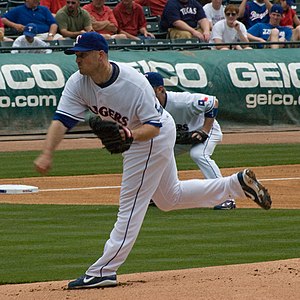
Jason Jennings is the only one of Rockies first-round draft picks to win the Rookie of the Year Award (2002).
The Colorado Rockies are a Major League Baseball (MLB) franchise based in Denver, Colorado. They play in the National League West division. The Rockies have participated in MLB's annual June draft since 1992. Officially known as the "First-Year Player Draft", the Rule 4 Draft is MLB's primary mechanism for assigning players from high schools, colleges, and other amateur clubs to its franchises. The draft order is determined based on the previous season's standings, with the team possessing the worst record receiving the first pick. In addition, teams which lost free agents in the previous off-season may be awarded compensatory or supplementary picks. Since the franchise was established as an expansion team in 1992, the Rockies have selected 31 players in the first round. The First-Year Player Draft is unrelated to the 1992 expansion draft through which the Rockies filled their roster.
Of the 31 players selected in the first round by the Rockies, 18 have been pitchers, the most of any position; 12 of these have been right handed, and 6 have been left-handed. The Rockies have also selected six outfielders, four shortstops, and one player each at catcher, first base, and third base. The Rockies have never selected a second baseman in the first round. The Rockies have drafted 16 players out of high school, and 14 out of college. Colorado has drafted seven players from high schools or colleges in the state of California, with five coming from Texas and three from Tennessee. The Rockies' 2002 selection—Jeff Francis—is the only selection from outside the United States.
None of the Rockies' first-round picks have won a World Series championship with the team. One pick has been elected to the Hall of Fame, Todd Helton who was the 8th overall pick in 1995. The Rockies' first-round selection in 1999—Jason Jennings—won the MLB Rookie of the Year award with the franchise in 2002, his first full season in the Major Leagues. Todd Helton—the Rockies' 1995 selection—has won four Silver Slugger Awards and three Gold Gloves, as well as being named to five All-Star teams. Casey Weathers, the Rockies' 2007 selection, won a bronze medal in baseball with the United States team at the 2008 Summer Olympics. The Rockies have never held the first overall pick in the draft, but held the second overall pick once, which they used in 2006 to select Greg Reynolds. (Full article...) -
Image 7
The All-Star Final Vote was an annual Internet and text message ballot by Major League Baseball (MLB) fans to elect the final player for each team that participates in the Major League Baseball All-Star Game, after all other selections were made and announced. The first 33 players were selected by a combination of procedures. The sponsorship changed annually, but the contest remained similar from year to year. Each league presented a five-man ballot and gave the fans a few days to choose one final All-Star. This process was used from 2002 through 2018. (Full article...) -
Image 8

Location of Puerto Rico's main island (green)
Puerto Rico currently has the fourth-most active players in Major League Baseball (MLB) among Latin American jurisdictions, behind the Dominican Republic, Venezuela and Cuba. More than three hundred players from the archipelago have played in the major leagues since 1926. This includes players who were born in either one of the archipelago's islands and those of Puerto Rican heritage. Only those players who have worked in the major leagues are listed, not those active in the minor leagues, nor negro independent leagues.
For years, it was considered that the first player from Puerto Rico to play in the major leagues was Hiram Bithorn in 1942. But this changed in December 2020, when seven Negro baseball leagues between 1920 and 1948 were recognized as "major leagues." Thus, the first Puerto Rican to play baseball on the major leagues was Jose "Gacho" Torres, who debuted in 1926. (Full article...) -
Image 9
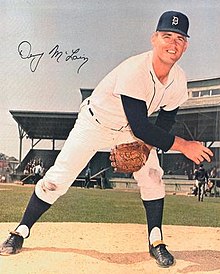
Dennis McLain, 1968 American League wins leader, with 31; this was the last time a pitcher has won thirty.
Major League Baseball recognizes the player or players in each league[a] with the most wins each season.[b] In baseball, wins are a statistic used to evaluate pitchers. Credit for a win is given by the official scorer to the pitcher whose team takes and maintains the lead while he is the pitcher of record. If a game is tied or if the lead changes to the other team, all pitchers who have participated and exited the game to that point are unable to receive credit for the victory. A starting pitcher is ineligible for the win unless he pitches at least five innings. (If he doesn't, but nevertheless leaves his team with a lead that it never relinquishes (a rather uncommon combination), the scorer would award the victory to the relief pitcher who was "most effective... in the official scorer's judgment".) (Full article...) -
Image 10

Todd Worrell (1982) is the only Cardinals first-round draft pick to win the Rookie of the Year Award.
The St. Louis Cardinals are a Major League Baseball (MLB) franchise based in St. Louis, Missouri. They play in the National League Central division. Since the institution of MLB's Rule 4 Draft, the Cardinals have selected 77 players in the first round. Officially known as the "First-Year Player Draft", the Rule 4 Draft is MLB's primary mechanism for assigning amateur baseball players from high schools, colleges, and other amateur baseball clubs to its teams. The draft order is determined based on the previous season's standings, with the team possessing the worst record receiving the first pick. In addition, teams which lost free agents in the previous off-season may be awarded compensatory or supplementary picks.
Of the 77 players picked in the first round by St. Louis, 39 have been pitchers, the most of any position; 30 of them were right-handed, while nine were left-handed. Eight outfielders, ten third basemen, six shortstops, six first basemen, five catchers, and two second basemen were taken as well. The team also drafted one player, Leron Lee (1966), who played as an infielder. 16 of the players came from high schools or universities in the state of California, and Texas and Arizona follow with seven and six players. The Cardinals have not drafted any players from their home state of Missouri. (Full article...) -
Image 11
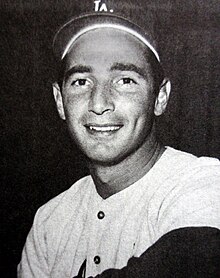
An immaculate inning occurs in baseball when a pitcher strikes out all three batters he faces in one inning using the minimum possible number of pitches: nine. This has happened 115 times in Major League history and has been accomplished by 105 pitchers (80 right-handed and 25 left-handed).
Major League Baseball's first immaculate inning was accomplished by John Clarkson of the Boston Beaneaters against the Philadelphia Quakers on June 4, 1889; and the most recent by Ryan Pepiot of the Tampa Bay Rays on September 18, 2024. Use of the term "immaculate inning" first appeared in newspaper reporting after 2000. (Full article...) -
Image 12

Keith Hernandez won eleven consecutive Gold Gloves at first base, the most by any MLB player.
The Gold Glove Award is the award given annually to the Major League Baseball players judged to have exhibited superior individual fielding performances at each fielding position in both the National League (NL) and the American League (AL), as voted by the managers and coaches in each league. Managers are not permitted to vote for their own players. Eighteen Gold Gloves are awarded each year (with the exception of 1957, 1985, 2007 and 2018), one at each of the nine positions in each league. In 1957, the baseball glove manufacturer Rawlings created the Gold Glove Award to commemorate the best fielding performance at each position. The award was created from a glove made from gold lamé-tanned leather and affixed to a walnut base. Initially, only one Gold Glove per position was awarded to the top fielder at each position in the entire league; however, separate awards were given for the National and American Leagues beginning in 1958.
Keith Hernandez has won the most Gold Gloves at first base, capturing 11 consecutive awards in the National League from 1978 to 1988. In the American League, Don Mattingly won nine times with the New York Yankees for the second-highest total among first basemen, and George Scott won eight awards playing for the Boston Red Sox (three) and the Milwaukee Brewers[a] (five). Vic Power[b], and Bill White each won seven awards; six-time winners include Wes Parker and J. T. Snow. Mark Teixeira has won five Gold Gloves at the position. Gil Hodges, Eddie Murray and Jeff Bagwell are the only members of the Baseball Hall of Fame to have won a Gold Glove at first base. (Full article...) -
Image 13

The 1980 Sounds set a team-best 97–46 (.678) record playing as the Double-A affiliate of the New York Yankees in the Southern League.
The Nashville Sounds Minor League Baseball team has played in Nashville, Tennessee, for 47 years since being established in 1978. As of the completion of the 2024 season, the club has played 6,566 regular-season games and compiled a win–loss record of 3,398–3,168–2 (.518). They have appeared in the postseason on 16 occasions in which they have a record of 49–44 (.527) in 93 games. Combining all 6,659 regular-season and postseason games, Nashville has an all-time record of 3,447–3,212–2 (.518).
Created as an expansion team of the Double-A Southern League (SL) in 1978, the Sounds played in this league through 1984. At the Double-A classification, Nashville was affiliated with Major League Baseball's Cincinnati Reds (1978–1979) and New York Yankees (1980–1984). The Sounds moved up to Triple-A in 1985 as members of the American Association (AA) before joining the Pacific Coast League (PCL) in 1998. They were placed in the Triple-A East (AAAE) in 2021, but this became the International League (IL) in 2022. At this level, they have been affiliates of the Detroit Tigers (1985–1986), Cincinnati Reds (1987–1992), Chicago White Sox (1993–1997), Pittsburgh Pirates (1998–2004), Milwaukee Brewers (2005–2014), Oakland Athletics (2015–2018), and Texas Rangers (2019–2020). The Sounds reaffiliated with the Milwaukee Brewers in 2021. (Full article...) -
Image 14
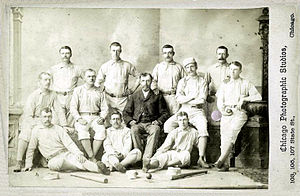
1882 Providence Grays
The Providence Grays were a Major League Baseball franchise based in Providence, Rhode Island from 1878 to 1885. During the team's eight seasons in the National League (NL), which then comprised eight teams, they finished third place or higher in the final standings seven times, and won the league championship in both 1879 and 1884. Providence played their home games at the Messer Street Grounds, which was located in the Olneyville neighborhood of Providence. The Grays were officially organized on January 16, 1878 by Benjamin Douglas, who became the team's general manager. Henry Root was hired as the team president‚ and Tom Carey was initially hired to be the on-field captain, whose duties were similar to the modern-day manager. On January 21, 1878, Providence applied for membership in the NL, and was officially approved on February 6. On April 10, Root took over ownership of the team, fired Douglas for incompetence and insubordination, and hired Tom York to replace Carey as captain.
Providence was successful in signing several star players for their inaugural season: Paul Hines had played the previous four seasons with the Chicago White Stockings; Tom Carey was signed after the Hartford Dark Blues folded; Doug Allison was the catcher for the 1869 Cincinnati Red Stockings, who had an 84-game winning streak from 1869 to 1870; and John Montgomery Ward, who was playing his first season in the major leagues. Ward had a win–loss record of 22–13 and Hines led the league in home runs, runs batted in (RBIs), and batting average as the Grays finished in third place among the six teams in the NL for the 1878 season, with a record of 33 wins, 27 losses, and 2 ties. The Grays won the NL championship in 1879, placing first among the league's eight teams with Ward winning 47 games as their starting pitcher, and the leadership of George Wright, who played second base and also managed. The team had a strong hitting line-up with Hines' league leading .357 batting average, as well as new additions Jim O'Rourke and Joe Start, who both had batting averages over .300. William Edward White, a Brown University player who played one game for the Grays on June 21, 1879, may have been the first African-American to play at the major league level; according to Peter Morris of the Society for American Baseball Research, the evidence for White is strong, but not conclusive. If this claim is true, then White pre-dated both Moses Fleetwood Walker and his brother Weldy Walker, who both played for the 1884 Toledo Blue Stockings of the American Association (AA). In 1880, the Grays finished in second place among the eight NL teams, with Ward winning 39 games. On June 17 of that year, Ward pitched the second perfect game in major league history. (Full article...) -
Image 15
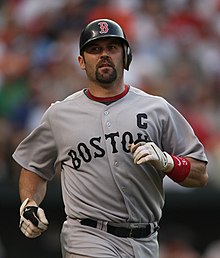
An All-American team is an honorary sports team composed of the best amateur players of a specific season for each position—who in turn are given the honorific "All-America" and typically referred to as "All-American athletes", or simply "All-Americans". Although the honorees generally do not compete as a unit, the term is used in U.S. team sports to refer to players who are selected by members of the national media. Walter Camp selected the first All-America team in the early days of American football in 1889. In 1950, the American Baseball Coaches Association (ABCA) selected its first All-American baseball team. It has since chosen All-American teams and a player of the year for each division (National Collegiate Athletic Association (NCAA) Division I, Division II, Division III, National Association of Intercollegiate Athletics, junior college, and high school). Collegiate Baseball selects All-American, Freshman All-American, and High School All-American teams. Baseball America magazine selects pre-season and post-season All-American teams and College Player of the Year honorees.
Various organizations selected All-American lists of the best players for the 1994 NCAA Division I college baseball season. The ABCA, the magazine Baseball America, and Collegiate Baseball were the NCAA-sanctioned selectors. This list only includes players selected to the post-season All-American first team for each selector. However, many All-American selections choose second, third, etc. teams from the remaining eligible candidates. (Full article...)
More did you know
- ... that Yoennis Céspedes was described by Baseball Prospectus as "arguably the best all-around [baseball] player to come out of Cuba in a generation"?
- ... that baseball outfielder Adam Eaton received USD $120,000 meant for the retired pitcher of the same name?
- ... that professional baseball player Bill Bagwell led three different leagues in batting average?
- ... that four men involved in the 1877 Louisville Grays scandal were banned from professional baseball for life?
- ... that Josh Bell received a US$5 million signing bonus, a record for a player chosen in the second round of the Major League Baseball Draft?
Sports portals
Selected picture

| Credit: National Photo Company Collection |
Walter Perry Johnson (November 6, 1887–December 10, 1946), nicknamed "The Big Train," was a right-handed pitcher in Major League Baseball between 1907 and 1927. One of the most celebrated players in baseball history, Johnson established several pitching records, some of which remained unbroken for more than a half-century.
Associated Wikimedia
The following Wikimedia Foundation sister projects provide more on this subject:
-
Commons
Free media repository -
Wikibooks
Free textbooks and manuals -
Wikidata
Free knowledge base -
Wikinews
Free-content news -
Wikiquote
Collection of quotations -
Wikisource
Free-content library -
Wikiversity
Free learning tools -
Wiktionary
Dictionary and thesaurus
More portals
- Portals with triaged subpages from June 2018
- All portals with triaged subpages
- Portals with no named maintainer
- Automated article-slideshow portals with 51–100 articles in article list
- Automated article-slideshow portals with 501–1000 articles in article list
- Random portal component with 41–50 available subpages
- Automated article-slideshow portals with 201–500 articles in article list
- Random portal component with 11–15 available subpages
- Random portal component with 21–25 available image subpages





